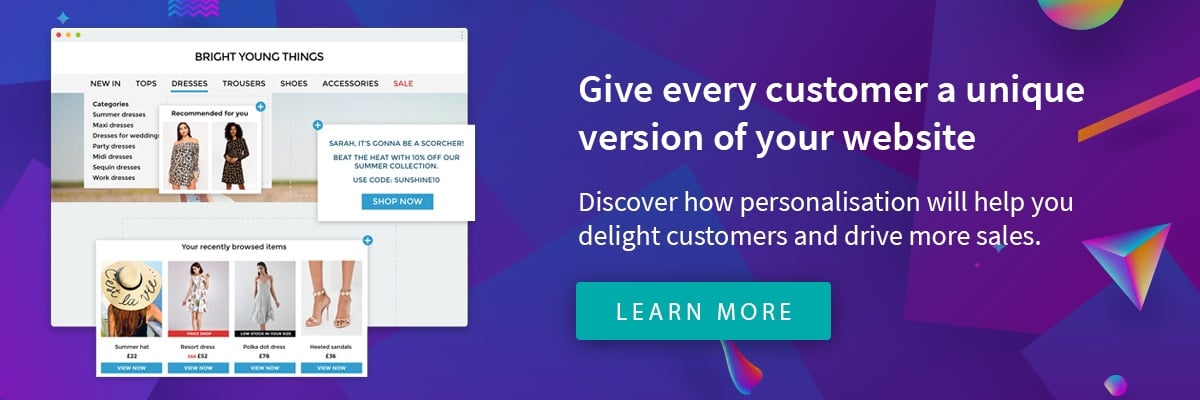As online sales grow each year, you’d be forgiven for thinking clicks are crushing bricks. But the sprawling eCommerce landscape doesn’t mean curtains for physical stores. Far from it.
Brick-and-mortar still accounts for over 90 percent of overall retail sales. Added to this, there’s a growing trend of online-first brands expanding into physical stores. Even the most digitally savvy retailers see a future in the high street.
So the high street may not be dead but it needs to adapt to how digital activity influences physical shopping. The challenge for retailers lies in finding ways to use key changes in consumer behaviour to their advantage. Could personalisation be the answer?
This article explores how personalisation can allow retailers to connect online and offline experiences to drive sales.
In-store experiences matter
Physical stores may have seen footfall drop in recent years. But this does not undermine the vital role they play in the modern customer journey.
In many sectors, shopping remains a cross-channel experience. Customers research online to narrow down their options. Then, before buying, they visit a brick-and-mortar store to confirm quality expectations. Google calls this process “webrooming”.
Webrooming brings products to life and give customers a glimpse of what owning them would be like. This requires much more imagination without physical stores.
Visits to physical stores ease customers along to their decision to buy. Smart retail brands understand this and find ways to take advantage of this in their marketing.
Perfect clicks, then build bricks
Recognising the value of in-store experiences to drive sales, increasing numbers of successful online-only businesses are now opening brick-and-mortar locations.
Warby Parker make £1 billion in eCommerce revenue and now operate 64 stores. Other brands such as Daniel Wellington and Matches of Fashion are following suit.
Unlike some retailers that fail to connect offline and online experiences, these online-first retailers understand the need to create a seamless customer experience.
These brands have obsessively crafted their online customer experience using personalisation. Now, they are translating the principles that allowed them to succeed online, to their physical stores.
Joining up the dots
So, how can brands connect in-store and online experiences effectively? Personalisation technology offers the answer.
A personalisation platform takes data from in-store transactions and connects this with online customer behaviour. This allows you to gain a real-time understanding of exactly where your customer is at in their journey.
By connecting both datasets, you can personalise the customer experience seamlessly. You are able to present each customer with personalised, contextually relevant offers online and in-store.
Cross-channel personalisation is a powerful way to reduce friction and ease customers along in their journey to purchase.

How to connect digital and physical
Here are five ways your brand can use cross-channel personalisation to connect digital and physical experiences:
1) Intelligent retargeting
Without cross-channel personalisation, in-store and online experiences can be disappointingly disjointed. For example, you may end up re-targeting a customer with a product that they researched online but have already purchased in-store.
Cross-channel personalisation combines online and in-store datasets to ensure your retargeting makes sense.
2) Cross-selling
Cross-channel personalisation allows you to make seamless use of cross-selling across digital and physical experiences. For example, you can cross-sell online by emailing product recommendations based on something your customer just bought in-store.
3) Enhancing post-purchase journeys
You may send a feedback email when someone buys online, but do customers get one after an in-store purchase?
Connecting in-store and online datasets ensures post-purchase journeys also exist for in-store purchases. This is an effective way to reduce buyer’s remorse and encourage repeat purchases.
4) Collecting data for targeting
Collecting data in-store as well as online allows you to gain rich information about customer preferences.
Having a fully-rounded view of the customer allows you to deliver effective targeted campaigns at key points in the customer journey.
5) Contextualising online experience
A customer’s physical context has a massive influence on how they behave online. For example, consider how search behaviour changes as the weather changes.
Personalising your website experience using location and real-time weather data enables you to deliver contextually relevant content and promotions for each customer. This increases engagement and drives sales.
Takeaway
Together, modern consumer behaviour and personalisation technology create a rich opportunity to enhance customer experience.
Brands that use personalisation intelligently to create a seamless customer experience — in-store and online — will reap the rewards in increased engagement and more sales.
Joining up bricks and clicks is crucial for brands that want compete against online-first brands. Brands that know how to do this innately.
This post offered five key ways to use personalisation to connect online and offline retail experiences. These ideas are easy to implement with the right personalisation platform in place. To see our personalisation technology in action, book a demo via the button below.

